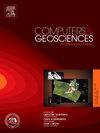Advancing raster DEM generalization with a quadric error metric approach
IF 4.4
2区 地球科学
Q1 COMPUTER SCIENCE, INTERDISCIPLINARY APPLICATIONS
引用次数: 0
Abstract
Generalizing Digital Elevation Models (DEMs)—a process that simplifies data while preserving essential features—is crucial for efficient land surface analysis and revealing hierarchical structures of landforms. However, traditional methods often struggle to balance simplification with feature preservation. This paper presents a novel approach for generalizing raster-based DEMs using Quadric Error Metrics (QEM). Traditionally used for polygonal simplification, QEM has been uniquely adapted to operate directly on gridded data, which is required by most geomorphometric calculation and analysis tools. By minimizing geometric distortion, QEM effectively maintains significant land surface features, even at high levels of generalization, where the limitations of existing methods become evident. This was confirmed through a methods comparison, evaluating the generalization level using local roughness measurements based on the circular variance of aspect on four distinct areas that vary considerably in terms of landform type. The QEM approach's implicit evaluation of local surface properties ensures that significant features are preserved without the need for explicit feature detection or extensive parameter tuning. The method employs an adaptive error threshold to progressively remove smaller, non-essential landforms, providing flexible control over the generalization process. The proposed method has significant implications for various applications utilizing DEMs, particularly for analyses for which micro-scale features are undesirable noise, but preservation of the terrain skeleton is especially important. By offering a robust tool for DEM generalization, this research aims to enhance support for digital geomorphological mapping, but it can also be useful for a wider range of geoscientific research.
用二次误差度量方法推进栅格DEM概化
泛化数字高程模型(dem)——一个在保留基本特征的同时简化数据的过程——对于有效的地表分析和揭示地貌的层次结构至关重要。然而,传统的方法往往难以平衡简化和特征保留。本文提出了一种利用二次误差度量(QEM)泛化栅格dem的新方法。传统上用于多边形简化,QEM已经独特地适应于直接操作网格数据,这是大多数地貌学计算和分析工具所需要的。通过最小化几何失真,QEM有效地保持了重要的地表特征,即使在高水平的泛化中,现有方法的局限性也变得明显。这是通过一种方法比较来证实的,在地形类型差异很大的四个不同地区,使用基于坡向圆方差的局部粗糙度测量来评估概化水平。QEM方法对局部表面性质的隐式评估确保了重要的特征被保留,而不需要显式的特征检测或广泛的参数调整。该方法采用自适应误差阈值逐步去除较小的、非必要的地形,为泛化过程提供灵活的控制。所提出的方法对利用dem的各种应用具有重要意义,特别是对于微尺度特征是不希望的噪声的分析,但保留地形骨架尤其重要。通过提供一个强大的DEM综合工具,本研究旨在增强对数字地貌测绘的支持,但它也可以用于更广泛的地球科学研究。
本文章由计算机程序翻译,如有差异,请以英文原文为准。
求助全文
约1分钟内获得全文
求助全文
来源期刊

Computers & Geosciences
地学-地球科学综合
CiteScore
9.30
自引率
6.80%
发文量
164
审稿时长
3.4 months
期刊介绍:
Computers & Geosciences publishes high impact, original research at the interface between Computer Sciences and Geosciences. Publications should apply modern computer science paradigms, whether computational or informatics-based, to address problems in the geosciences.
 求助内容:
求助内容: 应助结果提醒方式:
应助结果提醒方式:


